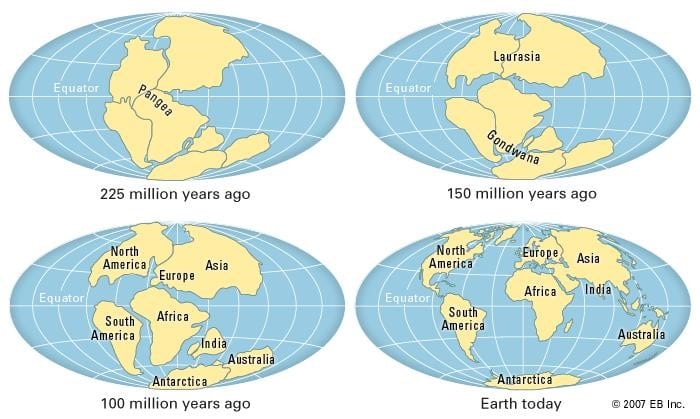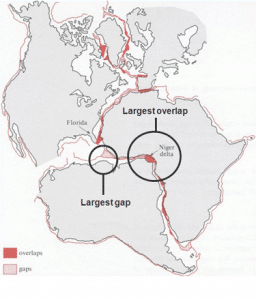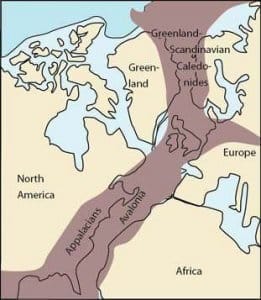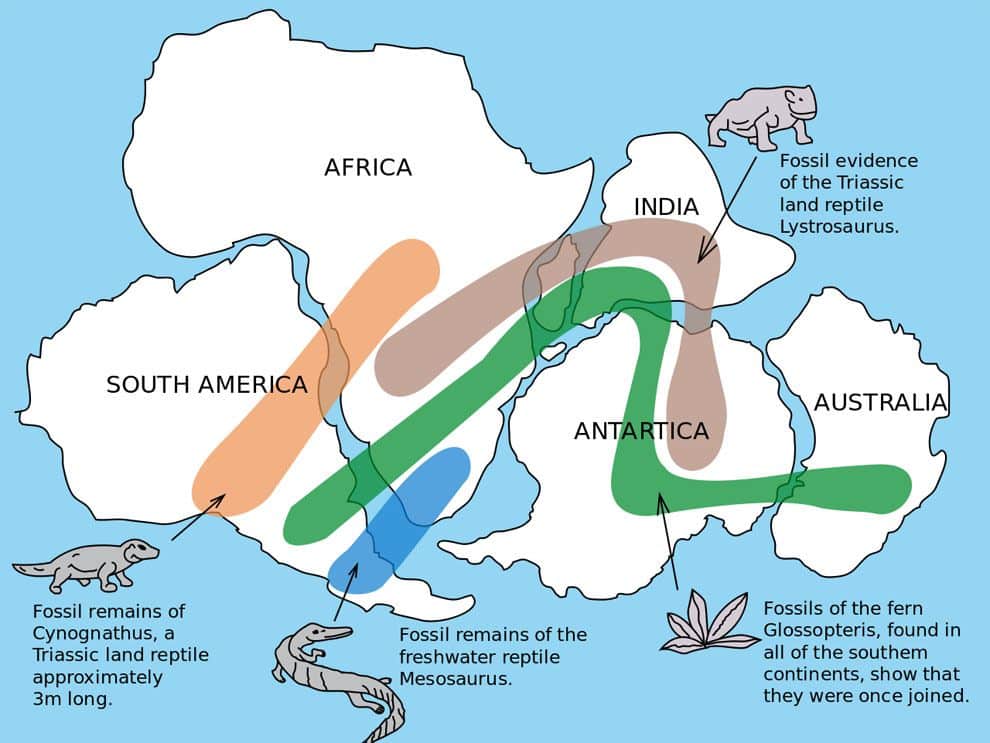- Continental Drift theory was put forth by Alfred Wegener, a German meteorologist, polar explorer, astronomer, and geologist. He is in fact known as the father of continental drift.
- In a lecture in 1912, Wegener proposed a startling theory of ‘continental drift’.
- The movement of continents across the ocean bed is known as continental drift. This drifting takes millions of years to complete this process.
- According to Wegener, all the continents formed a single continental mass which is called “Pangaea” which means all earth. This supercontinent was surrounded by a mega ocean called “Panthalassa ” meaning all water.
- Subsequently, Laurasia and Gondwanaland continued to break into various smaller continents that exist today. Thus, Wegener proposed that continents are floating and constantly drifting on the earth’s surface. His hypothesis later on became the basis of present day plate tectonic theory.

Various Stages of Continental Drift Theory
- The first stage occurred during the Carboniferous period, when Pangea, a supercontinent, was encircled by Panthalassa, a mega-ocean.
- In the second stages around 200 million years ago in the Jurassic period, the supercontinent, Pangaea, began to split. Pangaea first broke into large continental masses as Laurasia and Gondwanaland forming the northern and southern components respectively.
- In the third stages, the Tethys Sea progressively filled the area between Laurasia and Gondwanaland during the Mesozoic epoch, and it gradually broadened.
- In the fourth stage around 100 million years ago when North and South America drifted westward, resulting in the emergence of the Atlantic Ocean. The Rockies and Andes were formed by the westward drift of North and South America.
- The Orogenetic Stage in which mountain-building activity took place is the fifth stage.
Note: The Himalayas and Alps were constructed by the folding of Tethys Sea deposits.
Forces responsible for Continental Drift
There are two factors which are responsible for continental drift which are as follows:
- The continental drift was equatorward due to the combined action of gravitational forces, pole-fleeing force, and buoyancy force because the planet is not perfectly round and has a bulge at the equator.
- Note: The ‘pole-fleeing force’ is caused by an increase in centrifugal force from the poles towards the equator.
- The continental drift was westward due to tidal currents caused by the earth’s rotation.
- However, these two factors were eventually discovered to be insufficient reasons for continent drifting, which is considered a criticism of Wegener’s theory.
Evidence in support of the Continental Drift Theory
- The Matching of Continents (Jig-Saw-Fit): When facing one another, the shorelines of South America and Africa form a similarity. Similarly, when matched, Africa, Madagascar, and India’s east coast all fit together.

- Geological structure- there is a remarkable similarity in geological structure along the two coasts of the Atlantic. The best example is provided by the Appalachian mountains of North America which come right up to the coast and continue their trend across the ocean in the old Hercynian Mountains of southwest Ireland, Wales, and central Europe. The opposite coasts of Africa and Brazil display even greater resemblance in their structure and rocks.

- Permo-carboniferous glaciations- it presents strong proof that at one point in time these landmasses were assembled together since the evidence of this glaciation is found in Brazil, Falkland island, South Africa, the Indian peninsula as well as Australia. It is difficult to explain these extensive glaciations on the basis of the existing distribution of landmass and water. According to Wegener at the time of Pangaea, the South Pole was situated near Durban of the present coast of South Africa.
- Distribution of Fossils: Identical species and animals were found on both sides of the marine barrier. For example, Mesosaurus, a freshwater crocodile-like reptile that lived between 286 and 258 million years ago, is only found in Southern Africa and Eastern South America.
- Paleoclimatic evidence- Coal deposits have been found in temperate and polar regions; however, coal is formed in tropical regions.
- Biological evidence- The lemmings have the tendency to migrate westwards for the search of land, but these creatures have no idea that the land has shifted westwards and the sea awaits for their mass suicide i.e. the migratory pattern of some animal species also hints towards the joined landmass. For example, the entire lemming (a rodent) population crosses North America and falls in the Atlantic. This is estimated that they have not forgotten their route when the landmasses were joined, the might have traveled to Europe and Central Asia.

Criticism of Continental Drift Theory
- The continental drift theory was undeniably convincing. But so much of the theory was based on speculation and inadequate evidence. It provoked a lot of criticism and controversy.
- The greatest criticism of this theory was due to the controversial forces which were stated to have caused the drift.
- According to experts had the gravitational force of the moon or sun was so strong to cause the landmass to break, then it would have stopped the rotations of the earth and made it stationary.
- Also in order to cause a drift in a landmass, the rotations required should be at such a high speed that it would have thrown the atmosphere (the gases) and everything else in the outer space away from the earth’s gravitational pull.
- Precarboniferous history not known
- Why only northward and westward drift
- Sial floating over Sima – in reality, the lithosphere is floating on aesthenosphere
- The formation of mountains (Rockies and Andes) due to friction by Sima is self-contradictory
- Did not explain the formation of oceanic ridges and Island arcs.
Conclusion
- The Continental Drift Theory was rejected by the majority of scientists, and it was intensely disputed for decades following his death in 1930.
- The concept of conventional currents in the upper mantle was conceived in the 1920s. However, due to his early death, Alfred Wegener was unable to add the concept of conventional currents as the most compelling rationale for continental movement.
- Although the Continental Drift theory is no longer valid, the central premise of the theory was the driving force behind all subsequent modern hypotheses, such as plate tectonics and seafloor spreading.

accurate!
Thanks, Himaan
Nice, super.
Thank you so much🙏
Arise♥️🥇
Whenever i need something concrete topic to read ..i always see lotus arise .thanks a lot .
please increase size of images
Okay
Beautiful 📌
I think wegner has describe the formation of Island arc as ” N.continents move faster than South continents leads to breakage of land peices and Island arc form Ex: Aleutian Island.”
At a greater extent he made it
Accurate
IT GIVEN ANSWER OF EVERY Q RAISING IN MY MIND
Nice explanation, keep it up 👍